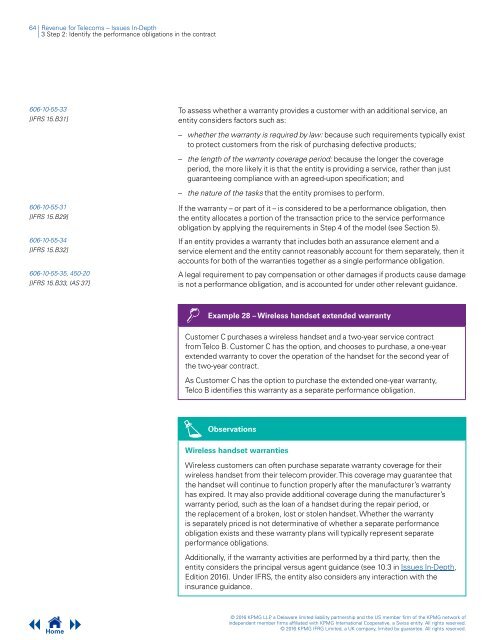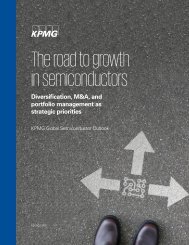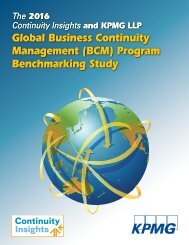Revenue for Telecoms
2cdncba
2cdncba
Create successful ePaper yourself
Turn your PDF publications into a flip-book with our unique Google optimized e-Paper software.
64 | <strong>Revenue</strong> <strong>for</strong> <strong>Telecoms</strong> – Issues In-Depth<br />
| 3 Step 2: Identify the per<strong>for</strong>mance obligations in the contract<br />
606-10-55-33<br />
[IFRS 15.B31]<br />
To assess whether a warranty provides a customer with an additional service, an<br />
entity considers factors such as:<br />
– whether the warranty is required by law: because such requirements typically exist<br />
to protect customers from the risk of purchasing defective products;<br />
– the length of the warranty coverage period: because the longer the coverage<br />
period, the more likely it is that the entity is providing a service, rather than just<br />
guaranteeing compliance with an agreed-upon specification; and<br />
– the nature of the tasks that the entity promises to per<strong>for</strong>m.<br />
606-10-55-31<br />
[IFRS 15.B29]<br />
606-10-55-34<br />
[IFRS 15.B32]<br />
606-10-55-35, 450-20<br />
[IFRS 15.B33, IAS 37]<br />
If the warranty – or part of it – is considered to be a per<strong>for</strong>mance obligation, then<br />
the entity allocates a portion of the transaction price to the service per<strong>for</strong>mance<br />
obligation by applying the requirements in Step 4 of the model (see Section 5).<br />
If an entity provides a warranty that includes both an assurance element and a<br />
service element and the entity cannot reasonably account <strong>for</strong> them separately, then it<br />
accounts <strong>for</strong> both of the warranties together as a single per<strong>for</strong>mance obligation.<br />
A legal requirement to pay compensation or other damages if products cause damage<br />
is not a per<strong>for</strong>mance obligation, and is accounted <strong>for</strong> under other relevant guidance.<br />
Example 28 – Wireless handset extended warranty<br />
Customer C purchases a wireless handset and a two-year service contract<br />
from Telco B. Customer C has the option, and chooses to purchase, a one-year<br />
extended warranty to cover the operation of the handset <strong>for</strong> the second year of<br />
the two-year contract.<br />
As Customer C has the option to purchase the extended one-year warranty,<br />
Telco B identifies this warranty as a separate per<strong>for</strong>mance obligation.<br />
Observations<br />
Wireless handset warranties<br />
Wireless customers can often purchase separate warranty coverage <strong>for</strong> their<br />
wireless handset from their telecom provider. This coverage may guarantee that<br />
the handset will continue to function properly after the manufacturer’s warranty<br />
has expired. It may also provide additional coverage during the manufacturer’s<br />
warranty period, such as the loan of a handset during the repair period, or<br />
the replacement of a broken, lost or stolen handset. Whether the warranty<br />
is separately priced is not determinative of whether a separate per<strong>for</strong>mance<br />
obligation exists and these warranty plans will typically represent separate<br />
per<strong>for</strong>mance obligations.<br />
Additionally, if the warranty activities are per<strong>for</strong>med by a third party, then the<br />
entity considers the principal versus agent guidance (see 10.3 in Issues In-Depth,<br />
Edition 2016). Under IFRS, the entity also considers any interaction with the<br />
insurance guidance.<br />
Home<br />
© 2016 KPMG LLP, a Delaware limited liability partnership and the US member firm of the KPMG network of<br />
independent member firms affiliated with KPMG International Cooperative, a Swiss entity. All rights reserved.<br />
© 2016 KPMG IFRG Limited, a UK company, limited by guarantee. All rights reserved.







